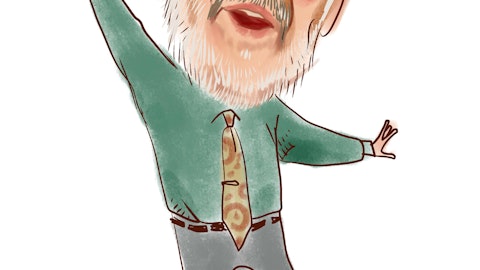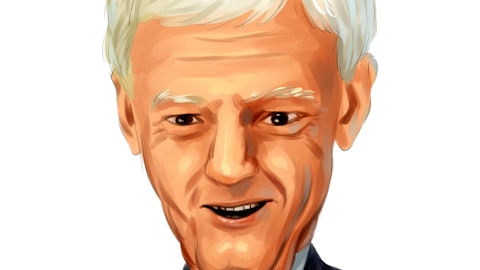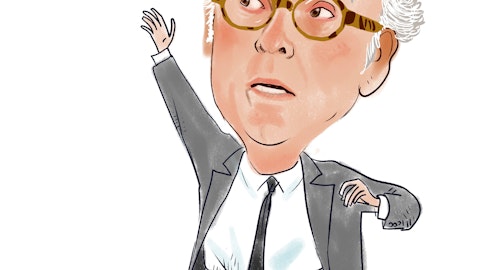KKR Real Estate Finance Trust Inc. (NYSE:KREF) Q4 2022 Earnings Call Transcript February 8, 2023
Operator: Good morning and welcome to the KKR Real Estate Finance Trust Inc. Fourth Quarter 2022 Financial Results Conference Call. All participants will be in a listen-only mode. . After today’s presentation, there will be an opportunity to ask questions. . Please note this event is being recorded. I would now like to turn the conference over to Jack Switala. Please, go ahead.
Jack Switala: Great. Thanks, operator, and welcome to the KKR Real Estate Finance Trust earnings call for the forth quarter of 2022. As the operator mentioned, this is Jack Switala. Today, I’m joined on the call by our CEO, Matt Salem; our President and COO, Patrick Mattson; and our CFO, Kendra Decious. I would like to remind everyone that we will refer to certain non-GAAP financial measures on the call which are reconciled to GAAP figures in our earnings release and in the supplementary presentation, both of which are available on the Investor Relations portion of our website. This call will also contain certain forward-looking statements which do not guarantee future events or performance. Please refer to our most recently filed 10-Q for cautionary factors related to these statements.
Before I turn the call over to Matt, I’ll provide a brief recap of our results. For the fourth quarter of 2022, we reported GAAP net income of $14.6 million, or $0.21 per diluted share, including a CECL provision of $21.2 million, or $0.31 per diluted share. Distributable earnings this quarter were $12.4 million, or $0.18 per share, including a write-off of $25 million, or $0.36 per share. Distributable earnings prior to realized losses were $0.54 per share relative to our Q4 $0.43 per share dividend, driven largely by the higher rate environment. Book value per share as of December 31, 2022 was $18, a decline of 1.5% quarter-over-quarter. Our CECL allowance decreased to $1.61 per share from $1.66 per share last quarter. Finally, in early December, we paid a cash dividend of $0.43 per common share with respect to the fourth quarter.
Based on yesterday’s closing price, the dividend reflects an annualized yield of 10.9%. With that, I would now like to turn the call over to Matt.
Matt Salem: Good morning, and thank you for joining us today. Before turning to the current market and company results, I’d like to reflect on KREF’s achievements during 2022. Despite a very challenging environment, we made significant progress enhancing our liquidity and diversifying our already best-in-class non mark-to-market liabilities. In 2022, we optimized and diversified our financing sources, and as a result, sit on record levels of liquidity. Last year, we added $2.5 billion of non mark-to-market liabilities. Notably, we increased the borrowing capacity on KREF’s corporate revolver by $275 million to $610 million and extended the maturity date through March 2027. This revolver is a key contributor to our nearly $1 billion in liquidity as of year end.
77% of our secured financing as of year end was completely non mark-to-market, and the remaining 23% is only mark-to-credit. In addition, we have $1.9 billion of CRE-CLO liabilities that are priced at attractive spreads and still in their reinvestment periods. In 2022, we grew our permanent equity base by 15% to $1.6 billion. We raised approximately $150 million of preferred equity at a 6.5 % fixed-for-life coupon. We completed two public offerings of common stock, resulting in net primary proceeds of $188 million. KKR reached its target long-term hold position of 10 million shares, representing 14% of our shares outstanding, resulting in market leading alignment between KKR and KREF. Equally as important was our disciplined approach to buying back shares, when KREF traded below book value.
In 2022, we repurchased 2.1 million shares for nearly $36 million. Since our May 2017 IPO, KREF has repurchased nearly $100 million of stock. I cannot overstate the impact of our partnership with our manager, KKR, and the strength of our real estate platform. KKR’s integrated real estate business provides us with a robust view of the current operating environment, which has become more dynamic over the past few quarters as the Federal Reserve has embarked on a virtually unprecedented pace of interest rate increases. This broader real estate platform collectively manages over $64 billion of AUM and has grown by approximately 60% since the end of 2021. For example, KKR’s real estate private equity team owns or manages over 90 million square feet of industrial assets and over 30,000 multifamily units globally.
We are able to draw on real time data and market intelligence from this property portfolio, which informs our investment decisions as a lender. The KKR real estate credit business is substantial in its own right, with $30 billion of assets under management and a dedicated team of 66 at year end 2022, with nine senior investors responsible for over $10 billion in originations. As a reminder, KREF is KKR’s flagship senior transitional CRE lending strategy and holds a first priority position within the allocation waterfall. This team originated $2.7 billion on behalf of KREF in 2022 across 25 loans, concentrated our efforts in the growth property types, with nearly 70% secured by multifamily and industrial properties and another 22% secured by life science properties.

Photo by Ярослав Алексеенко on Unsplash
Our focus on lending to institutional sponsors on high quality real estate and growth sectors and markets has positioned us well to navigate the current environment. Our largest property type is multifamily, which represents approximately 45% of the overall portfolio. We continue to see strong performance across that segment, with median same-store rental rates up 12% in the portfolio of fourth quarter of 2021 to the first fourth quarter of 2022. That said, and as we discussed last quarter, the office sector remains challenged with little liquidity across both debt and equity. Our underweight and office will benefit KREF on a relative basis, we are diligently working through our watch list office loans. Our first preference is to work with our existing sponsors.
However, many properties will require additional capital and sponsors will need to demonstrate commitment to the asset with additional equity. We are not in the free option business. And our mindset is to deal with any issues now, and not to kick the can down the road with a sponsor, who is not economically incentivized to lease the current market rates. Fortunately, we have many tools at our disposal to optimize these outcomes, including taking title and operating assets until the liquidity returns. We’re also in a position to be proactive with our borrowers and work towards faster resolutions. Because we have high levels of liquidity at the corporate level. Turning to earnings. The high interest rate environment continues to be a tailwind for our distributable earnings.
In 2023, we expect the portfolio to turn over modestly, and we will continue to match originations with repayments. We expect repayments for 2023 to be approximately $1 billion, weighted to the back half of the year. As we navigate this New Year, we’re very well-positioned with a strong portfolio, best-in-class liabilities and record levels of liquidity. Lastly, I want to take a moment to thank Todd Fisher, who resigned from the KREF Board of Directors earlier this month to accept a position with the United States Department of Commerce. Mr. Fisher has been an integral part of our team since KREF inception. And we thank him for his thoughtful guidance and steering the company. We wish him well and as future endeavors. With that, I’ll turn the call over to Patrick.
Patrick Mattson: Thank you, Matt. Good morning, everyone. I’ll focus today on our efforts on the capital and liquidity front and provide an update around our CECL reserve and watch lists loans. In 2022, with the continued help of our partners in KKR Capital Markets, we added $2.5 billion in non mark-to-market financing. In the public capital markets, we closed $1 billion managed multifamily CLO earlier in the year, providing KREF with $848 million of non mark-to-market and non-recourse financing the two-year reinvestment period. In the private markets, we closed on a term lending agreement totaling $350 million with an option to increase the facility to $500 million and entered into three new asset specific financing facilities, totaling nearly $500 million.
We also increase the borrowing capacity of an existing $500 million term lending agreement to $1 billion. Finally, we increased our corporate revolver by $275 million to $610 million, and extended the maturity date through March 2027. Of the $2.5 billion in total capacity added this year, two-thirds is truly bespoke liabilities. The resiliency of our financing structure, coupled with our independence from the public capital markets, is a true differentiator. In buffers KREF on the liability side, during times of capital markets volatility. KREF is well capitalized today, and continuing to preserve flexibility in today’s market environment. Our debt to equity ratio was two times, and our total leverage ratio was 3.8 times as of quarter end. Our approach to managing the balance sheet allows us to start 2023 with a record level of liquidity in excess of $950 million, including our $610 million undrawn corporate revolver, and $240 million of cash.
Additionally, at quarter end, KREF had $180 million in unencumbered senior loans on the balance sheet. We’re maintaining our defensive posture with a focus on managing liquidity. This quarter, we recorded a $4 million net decrease in our CECL reserve of $115 million to $111 million or 147 basis points based on the funded loan portfolio. Similar to our commentary in Q3, nearly half of our total CECL reserve remains held within our five rated loans. Additionally, as we noted last quarter, the CECL reserve is unrealized in non-cash. We would recognize a loss through our cash metric of distributable earnings, if such amounts are deemed non-recoverable, as we did this quarter. Turning to the watch list, in December, we finalize the plan to modify a $161 million senior office loan, previously risk-rated 4 located in Philadelphia.
As part of the modification, KREF agreed to subordinate 25 million of our senior loan in the form of a junior mezzanine loan, in return for a $25 million principal repayment from the sponsor. The principal repayment is structured as a new senior mezzanine loan and reduces KREF’s mortgage exposure to $111 million. At year end, the loan was risk-rated 5 However, following the execution of the modification in January, the new senior loan was upgraded to a risk rating of three. In addition to the $25 million pay down, the sponsor committed to fund an additional $16.5 million for future capital expenditures and leasing cost, which will bring the total senior mezzanine loan balance to $41.5 million fully funded. The subordinated hope note is structured as a junior mezzanine loan and does have priority of cash flow once a senior mortgage and senior mezzanine loans are fully repaid with interest.
KREF wrote off $25 million of the loan balance in Q4. Regarding our other two risk-rated 5 loans, there are sponsored lead sale processes in progress, and we are maintaining an active dialogue with these sponsors. With Minneapolis loan, we executed a short-term extension to facilitate the sale process. And for the other Philadelphia loan, we have an initial maturity date in May of this year. With regard to the broader portfolio, 88% of our loan portfolio remains risk-rated 3, and we collect it 100% of scheduled interest payments across the portfolio in Q4 and through the first payment date in 2023. A few final comments. KREF finish 2022 strong with a $7.9 billion total funded portfolio representing a 17% year-over-year increase. We originated three senior loans in Q4 for a total of $370 million in sourcing closed $125 million asset specific financing.
Finally, we repurchased approximately 500,000 shares of common stock in Q4 as a weighted average price per share of $16.41 or a total of over $7.4 million. Over the last three quarters, we’ve been opportunistic in utilizing our share repurchase program, with 2.1 million shares repurchased in 2022 for a total of $36 million. Additionally, this month, the board reauthorized $100 million buyback program. Thank you for joining us today. And now we’re happy to take your questions.
See also Buffett Stock Portfolio: Recent Buys and 13 Best Value Dividend Stocks to Buy.
Q&A Session
Follow Kkr Real Estate Finance Trust Inc. (NYSE:KREF)
Follow Kkr Real Estate Finance Trust Inc. (NYSE:KREF)
Operator: And our first question will come from Don Fandetti of Wells Fargo. Please go ahead.
Don Fandetti: Hi, good morning. Obviously office continues to be a pressure point. Can you talk a little bit on how your borrowers are handling the higher rate environment? Are you making modifications? And just talk a little bit about your expectations. I would assume that there’ll be more reserve building on your office portfolio as we go forward through 2023?
Matt Salem: Sure, Don, it’s Matt. Thank you for the question today. I appreciate you joining the call. I’d say specifically, let’s start at the interest rate environment right now, certainly putting a lot of pressure on the overall system. However, borrowers do have interest rate caps in place. And so, they’re not fully exposed to current SOFR, or current LIBOR, if we haven’t converted it over yet. And then clearly, as those interest rate caps expire, typically at the initial maturity date of the loan, they are required to re-up those interest rate caps and buy a new one. And that’s really when the conversations take place around potential modifications on the loan, it’s another opportunity for us to take a look at the credit and understand where we are and add any other structural features that we want.
And we’ve been working with our sponsors in terms of giving them some flexibility on their interest rate caps. So for instance, if interest rate cap requires a two-year term or requires a very low strike, accommodating them to either a shorter duration or a little bit higher strike and return for typically cash reserves that we would hold for future interest rate cap purchases, et cetera. Yes, so we want to work with them and help alleviate definitely pressure points as it as it relates to that, but it’s typically in return for some type of other consideration within the loan document. As it relates to further build up on office, in terms of our reserves, we go through the portfolio every quarter. And where we stand now, we feel comfortable with the reserves.
It is a very robust process. I think we’re eyes wide open. You’ve seen us, it’ll be very transparent and pretty front footed as it relates to not only increasing reserves, but as you saw this quarter, modifying loans and trying to get to the other side and create the right basis for us and for sponsors so that they can lease in what’s a difficult operating market for Office. So feel comfortable right now with where we stand on the reserves, and we’ll just have to see what the future brings in terms of how we’re positioned elsewhere.
Don Fandetti: Thanks.
Operator: Our next question comes from Rick Shane of J.P. Morgan. Please go ahead.
Rick Shane: Thanks, everybody, and appreciate for taking my question this morning. Look, one of the few places where GAAP and tax diverge is related to realize losses. So, to the extent you did realize a GAAP loss of $25 million. I’m curious if you believe that it’s met the threshold from an IRS or tax perspective, as well. And then, if you could talk specifically about, because it occurred in the fourth quarter, but perhaps the tax loss might be realized in 2023. How we should think about the timing and how that falls?
Kendra Decious: Sure. Thank you, Rick, appreciate you joining and appreciate the question. The — you asked about the write-off that we incurred in Q4 and that $25 million write-off will be a taxable event in the year the modification closed, which was 2023. Maybe pulling the thread on this a little bit, the sum of our quarterly dividends paid in 2022 plus borrowing part of the dividend that was paid in January 2023. And the throwback dividend concept is a practice that’s allowed under the REIT rules and that we’ve used in the past, means that we are fully distributed for 2022. And so, there is no special dividend that would be required.





